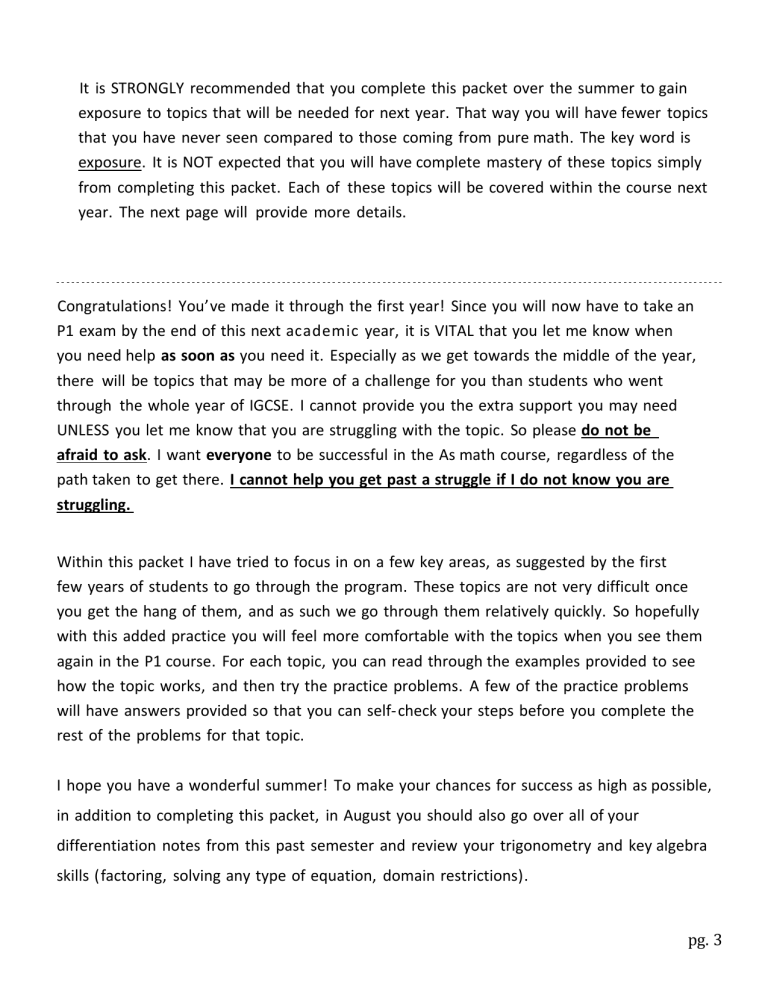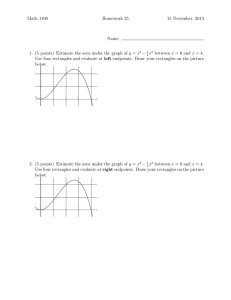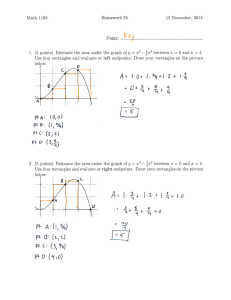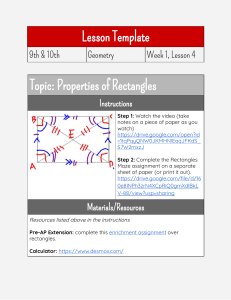
It is STRONGLY recommended that you complete this packet over the summer to gain exposure to topics that will be needed for next year. That way you will have fewer topics that you have never seen compared to those coming from pure math. The key word is exposure. It is NOT expected that you will have complete mastery of these topics simply from completing this packet. Each of these topics will be covered within the course next year. The next page will provide more details. Congratulations! You’ve made it through the first year! Since you will now have to take an P1 exam by the end of this next academic year, it is VITAL that you let me know when you need help as soon as you need it. Especially as we get towards the middle of the year, there will be topics that may be more of a challenge for you than students who went through the whole year of IGCSE. I cannot provide you the extra support you may need UNLESS you let me know that you are struggling with the topic. So please do not be afraid to ask. I want everyone to be successful in the As math course, regardless of the path taken to get there. I cannot help you get past a struggle if I do not know you are struggling. Within this packet I have tried to focus in on a few key areas, as suggested by the first few years of students to go through the program. These topics are not very difficult once you get the hang of them, and as such we go through them relatively quickly. So hopefully with this added practice you will feel more comfortable with the topics when you see them again in the P1 course. For each topic, you can read through the examples provided to see how the topic works, and then try the practice problems. A few of the practice problems will have answers provided so that you can self-check your steps before you complete the rest of the problems for that topic. I hope you have a wonderful summer! To make your chances for success as high as possible, in addition to completing this packet, in August you should also go over all of your differentiation notes from this past semester and review your trigonometry and key algebra skills (factoring, solving any type of equation, domain restrictions). pg. 3 This past semester we spent a lot of time looking at the topic of differentiation. One of the first main new topics that you will see is anti-differentiation. Anti-differentiation is the inverse process of differentiation. For instance, we know that the derivative of y = x3 is 3x2 . So it should make sense to say that an anti-derivative of 3x2 is x3 . However, it is important to say an anti-derivative of 3x2 rather than the anti-derivative of 3x2 for the simple reason that the derivative of y = x3 is 3x2 , but so is the derivative of y = x3 + 2, y = x3 − 5, and y = x 3 + 6 (and so on for any y = x3 ± some constant). So when we go backwards to the anti-derivative it is impossible to determine which exact function it came from without more information about the original function. So to cover ourselves for whatever that constant may be, we say that the anti-derivative of 3x2 is y = x3 + C, where C represents a constant. We call C the constant of integration. [ note: one point in the free response questions involving anti-derivatives is given simply for writing the “+C”, and no other points are given after that if it is forgotten, so it is VITAL to make sure you don’t forget it!] The process of taking anti-derivatives is called integration, specifically indefinite integration because of the constant of integration C. For the differentiation process we have the notation (f(x)) to derive some function f(x). For the anti-differentiation process we use the symbol to integrate. The anti-differentiation process has the notation f (x)dx to integrate some function f(x). The dx tells you what the important variable is when you are integrating – what you are integrating in terms of. Just as we had differentiation rules to memorize, we have corresponding integration rules that MUST be MEMORIZED. pg. 3 Within the course we’ll take a look together at compensating for Chain Rule with integrals, and learn the other methods of integration for when it does not match one of these basic rules from the charts. But all of that work will seem easier if you can get extra practice with the basic rules to start. Example #1 – Indefinite integration NOTE: You should ALWAYS be able to check your integration answers by taking the derivative of your answer and making sure you get what’s in the integral you started with. pg. 4 Until we learn some of the other methods and how to compensate for Chain Rule, here are a few tricks to get back to basic rules: Example #2 – Indefinite integration tricks pg. 5 Indefinite Integration PRACTICE = - qx + = 0 x 9x - = + C = + - x8x5 = It 5x = - x +1 2 - - xx5 2x 0 + 3 = x= - C + x - 2x = + - IX - 2X x11) =(t219 2x4 4 + 8 + Ix + 2x + - 5x 2 + + 6t)dX + (19+ = 0 + 9 + 3x5 + + 3++ = 2 + + (419x44 - 12x)(3 x-2) ax 18x2+12x 8-36xx) 10x+ C /412x3 - -5 2ixY- = = = = - 2 - - - = = * Ex 7xx + = 5x+25x = + - 4) - c xx 5 25x =(12 24 2x)dx x) Ye c + + = 8x5 2 - - x 2x+ = =S(x25-10X(dX + 0 + + - dx = 4xx5 - =x *x 0 f x 5x5x5 c + = - + = + + (5x5 = =(3x5 dX 3x5x 2 - + - + x + 3x4x5 c + 3x 3x 55)+8 x x+c = + 2x +0 = + x5x5 x 6x x2 C = + + x Ex x8 = = = + = dx =) 6x 2 x x5x5 x4x+ 2 + - = 5x2 - 4 dX - 32x 32 x 72x-32x+C + b4xie 6t3)dX + tj +2t c + + + =x pg. 6 - 8x 0x 2 + + We will look at four techniques to estimate this area: right rectangles, left rectangles, midpoint rectangles, and trapezoids. You can use any number of rectangles or trapezoids to estimate the area, and the more of them you use the more accurate your approximation will be. [ Exam Note : Any Riemann sum calculated is an approximation and, like the derivative approximations, will require the ≈ symbol to earn your answer point on the exam.] The first step in any Riemann sum problem is to figure out how many rectangles or trapezoids you will be using to break down and approximate the area. The next step will be to figure out the width of each of the rectangles or the height of each trapezoid. Then depending on which type of sum you are setting up, you can find the lengths for each rectangle and the bases for each trapezoid. For the problem given to start, we will first approximate the area by using four rectangles or four trapezoids. This makes our work easier, because if we break down from x = 1 to x = 5 into 4 pieces (n = 4), each piece will be one unit wide: RIGHT RECTANGLES R1 4 LEFT RECTANGLES R2 L1 4 L2 = MIDPOINT RECTANGLES L3 4 L4 R3 R4 2 3 2 2 2 2 3 4 4 5 Each rectangle has height that Each rectangle has height that corresponds to the right endpoint of corresponds to the left endpoint of the interval . In this instance, you can the interval . In this instance, you can see that more of the actual area is see that more of the estimate area missing than what extends over the extends over the curve than actual curve – so this would be an area missing – so this would be an underestimate . NOTE: NOT all right overestimate. NOTE: NOT all left sums are underestimates. sums are overestimates. TRAPEZOIDAL SUMS 2 3 M4 2 4 5 Each rectangle has height that corresponds to the midpoint of the interval . This is the closest rectangle approximation to the actual area. Each trapezoid has height along the x- axis and one base is the length up to the left endpoint and one base the length up to the right endpoint of each interval . You can see that clearly this is the closest ( best) approximation. 1 2 M3 3 5 4 M1 M2 1 1 1 = 1. 4 5 pg. 8 RIGHT RECTANGLES pg. 10 Ex. 4 – Riemann sums using equation Let f(x)= x2 − 3. We want to estimate the area under the curve using 8 rectangles/ trapezoids from x = 2 to x = 6. Although it’s not necessary, we can take a look at the graph. From here it can be helpful to make a list or table of values so we know the heights for the rectangles and the bases for the trapezoids. For the x-values, we start at 2 and go by until we reach 6. Then fill in the corresponding y-values using the function. (You may use fractions or decimals, whichever seems easiest to you.) Note: If you use decimals, it must be AT LEAST 5 decimal places used so that FINAL answer is accurate to three decimal places. 2 1 x f( X) 2.5 3.25 3 6 h of R1 2.5 3.25 h of R2 3 6 3.5 9.25 4 13 4.5 17.25 5 22 5.5 27.25 6 33 RIGHT RECTANGLES x f( X) 2 1 h of R3 3.5 9.25 h of R4 4 13 h of R5 4.5 17.25 h of R6 5 22 h of R7 5.5 27.25 h of R8 6 33 pg. 10 LEFT RECTANGLES x f( X) h of L1 2 1 h of L2 2.5 3.25 h of L3 3 6 h of L4 3.5 9.25 h of L5 4 13 h of L6 4.5 17.25 h of L7 5 22 h of L8 5.5 27.25 6 33 MIDPOINT RECTANGLES Midpoint rectangles are more complicated because we must make a new table with the midpoints of each interval from the original table. For instance, for the first midpoint it will be x f( X) h of M1 2.25 33/16 h of M2 2.75 73/16 = 2.25, the next h of M3 3.25 121/16 h of M4 3.75 177/16 = 2.75, and so on. h of M5 4.25 241/16 h of M6 4.75 313/16 h of M7 5.25 393/16 h of M8 5.75 481/16 TRAPEZOIDAL SUM x f( X) b1 2 1 b2 2.5 3.25 b3 3 6 b4 3.5 9.25 b5 4 13 b6 4.5 17.25 b7 5 22 b8 5.5 27.25 b9 6 33 Ex. 5 – Riemann Sums using table of values Cedar brook golf course is constructing a new green. To estimate the area of the green, the caretaker draws parallel lines 10 feet apart and then measures the length of the green along that line. Determine how many square feet of grass sod must be purchased to cover the green if: ( a) The caretaker is lazy and uses 4 midpoint rectangles to calculate the area. (b) The caretaker uses 8 left rectangles to calculate the area. (c) The caretaker uses 8 right rectangles to calculate the area. (d) The caretaker uses 8 trapezoids to calculate the area. Length (ft) 0 28 50 62 60 55 51 30 3 Just so you get the basic idea, you can imagine the golf green sliced into strips 10 feet apart . The 10 feet apart will be one dimension for our estimate and we’ll use the distance at each line measured as the other dimension for our estimates. The first right rectangle is drawn in the diagram (width 10, height 28). pg. 12 (a) For the midpoint sum, since we are only using 4 rectangles, each width will be 20 ft. h of M1 Length (ft) 0 28 h of M2 50 62 h of M3 60 55 h of M4 51 30 3 A ≈ M4 = 20 28 + 20 62 + 20 55 + (20) 30 = 3500 ft2 A ≈ 3500 ft2 (b) For the left sum, we are using 8 rectangles, each width will be 10 ft. (The 10 feet marker lines split the area into 8 rectangles.) h of L1 h of L2 Length (ft) 0 28 h of L3 h of L4 h of L5 h of L6 h of L7 h of L8 50 60 51 62 55 30 3 A ≈ L8 = 10 0 + 10 28 + 10 50 + 10 62 + 10 60 + 10 55 + 10 51 + (10) 30 = 3360 ft2 A ≈ 3360 ft2 (c) For the right sum, we are using 8 rectangles, each width will be 10 ft. Length (ft) 0 h of R1 h of R2 h of R3 h of R4 h of R5 h of R6 h of R7 h of R8 28 51 3 50 62 60 55 30 A ≈ R8 = 10 28 + 10 50 + 10 62 + 10 60 + 10 55 + 10 51 + 10 30 + 10 (3) = 3390 ft2 A ≈ 3390 ft2 (d) For the trapezoidal sum, we are using 8 trapezoids, each height will be 10 ft. b1 Length (ft) 0 b2 28 A ≈ T8 = + + b3 50 b4 62 b5 60 + + b6 55 + + b7 51 b8 30 b9 3 + = 3375 ft2 A ≈ 3375 ft2 pg. 13



